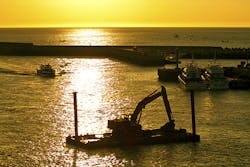The RIGHT Way To Do Offline Filtration On Hydraulic Systems
A very frustrated Hydraulics Pro Club member sent me this recently:
"I have done all but beg the company I work for to buy a portable oil filtration caddy but I cant seem to get my point across to them. The company is a government contractor and everything is done on a cost basis at the moment. So it's cheaper to mix oils today because they got a 'deal' on oil, or it's cheaper to change oil than it is to buy an offline filtration system, or most parts are cheaper than the filtration system, or the worst excuse I've been given so far is 'we have a lot of oil, no need to filter it'! Nevertheless, I will win this battle eventually and so I am looking for the proper procedure to filter the fluid in a hydraulic system."
This is a great example of being penny wise and dollar foolish. And of what happens when bean counters or managers with no technical knowledge are allowed to run the show. As you might expect under this management regime, another major point is being missed as well. That is: why are we changing the oil?
Certainly, water or particulate contamination doesn't normally necessitate an oil change. These contaminants can be filtered out. But offline filtration is not a cure for all the ailments that can afflict the oil either.
Like a doctor treating a sick patient, a diagnosis is required before the correct treatment can be prescribed. So plugging-in a filter cart once a week, month or year, without any signs or symptoms of an illness, is over-servicing. And like taking antibiotics when you're not sick, it won't do any harm, but it's an unnecessary waste of money.
If you follow this logic, even though this member's intentions are sound, he's putting the cart before the horse (no pun intended). The logical first step would be to convince his masters to set up an oil analysis program. Done right, this will provide all the information required to manage the oil in the most cost effective way.
He will then know when to plug-in the filter cart and what he's got to remove. Is it hard particles, soft particles (varnish and sludge) and/or water? And just as importantly, he'll know when there is no point plugging in the filter cart any more - because the oxidative life of the oil is used up or the additives are depleted. Just as there is no point flogging a dead horse, there's no point filtering dead oil.
And when it is time to plug in the filter cart, subsequent oil analysis - or at least a particle count - is the only scientific way to know when to switch it off. With all this said, what steps should be followed when filtering the oil?
Assuming a portable filter cart is being used, it should be connected to the hydraulic reservoir in such a way that its inlet and return are as far away from each other as possible. Ideally, the oil should be at operating temperature with the system functioning. This ensures exchange of the oil in the tank with that in the system.
The time it will take to clean-up the oil will depend on the type and concentration of the contaminants, the volume of the hydraulic system and the capacity of the filter cart.As already mentioned, the oil should be filtered until oil analysis reveals that the target cleanliness has been achieved. But as a general rule of thumb, the total volume of oil in the system should pass through the filter cart a minimum of 7 times.
For example, say we have a hydraulic system with a 100 gallon reservoir. We plan to have the filter cart running while the hydraulic system is operational and we estimate there is a further 40 gallons in the rest of the system. So the total oil volume is 140 gallons. If our filter cart has a flow rate of 0.5 gallons per minute, then based on the 7 times rule, the filtration time would be calculated as follows:
7 x 140 = 980 gallons
1540/0.5 = 1960 minutes or 32.6 hours
Clearly, in this example a bigger filtration cart would be nice. Although in an industrial application, a filtration time of this duration is probably acceptable. Keep in mind this is a thumb rule only and the ultimate determinant of success is when oil analysis confirms it.
Bottom line: plugging in a filter cart when it's not necessary or not constructive is a mistake. To discover six other costly mistakes you want to be sure to avoid with your hydraulic equipment, get "Six Costly Mistakes Most Hydraulics Users Make... And How You Can Avoid Them!" available for FREE download here.
About the Author
Brendan Casey Blog
Author
Brendan Casey is a war-weary and battle-scarred veteran of the hydraulics industry. He's the author of The Hydraulic Troubleshooting Handbook, Insider Secrets to Hydraulics, Preventing Hydraulic Failures, The Definitive Guide to Hydraulic Troubleshooting, The Hydraulic Breakdown Prevention Blueprint and co-author of Hydraulics Made Easy and Advanced Hydraulic Control. And when he's not writing about hydraulics or teaching it, Brendan is flat-out helping consulting clients from a diverse range of industries solve their hydraulic problems. To contact him visit his company's Website:
www.HydraulicSupermarket.com

Leaders relevant to this article:

